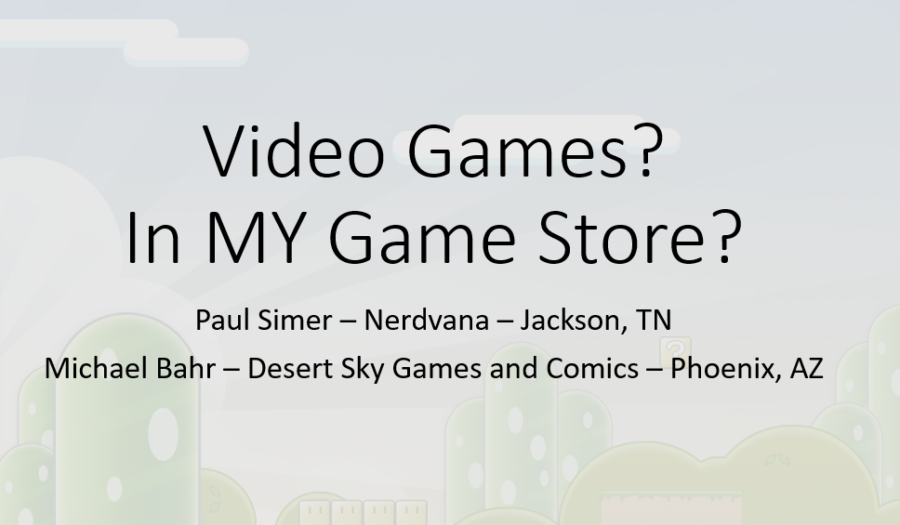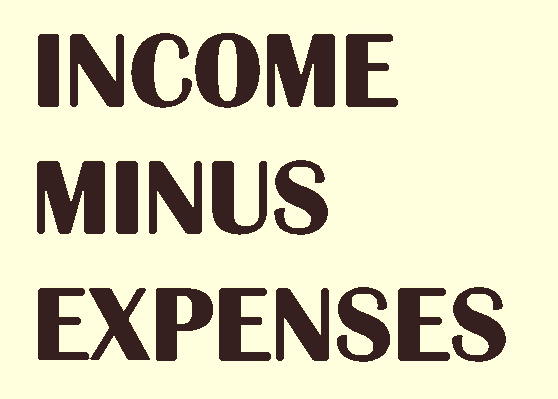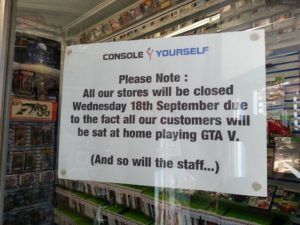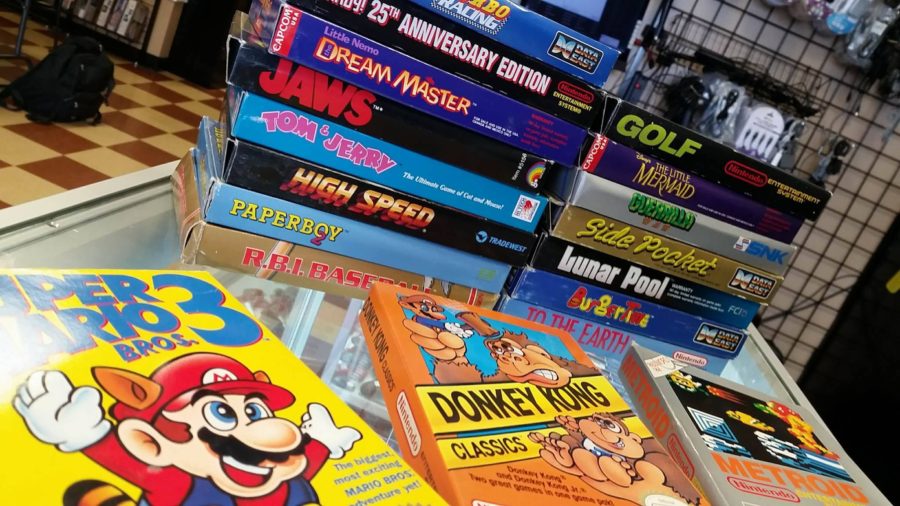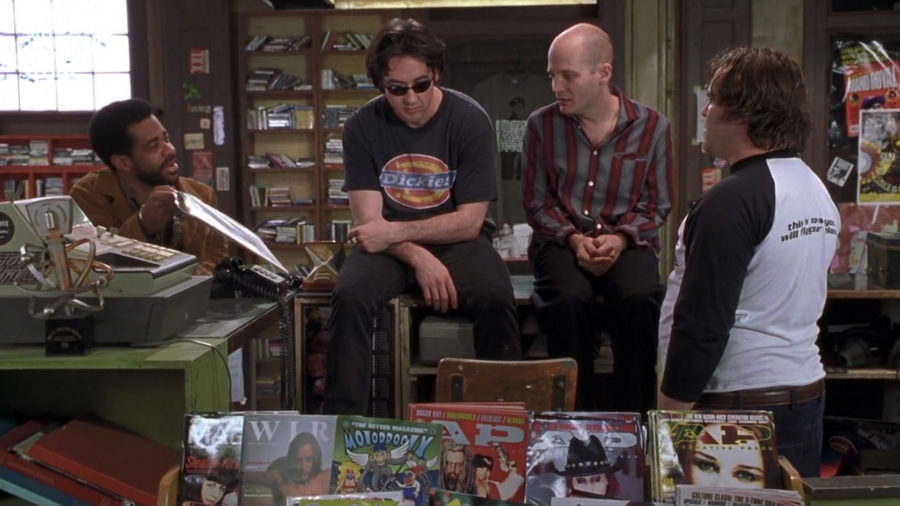This is a super-crunchy, kinda mathy post, but if you hang in there, you might find yourself making a lot more money running a much better business.
When I started this post I wasn’t really sure who it was for. Really it’s most useful to those who are developing point-of-sale solutions for game stores, but there’s not many of those people, and most of my current readers are game store owners. I suppose that this is still useful to them as both an introduction to what I think is an important concept, and an idea of a feature in their Point of Sale solution that they didn’t know they were missing. Customers of POS vendors: You need to be asking for this.
I’m going to talk about the problem in terms of video games for the most part, because that’s where it started for me and it’s where I think examples will be the most relatable. I’ve now come to see that this is every bit as essential if you’re dealing in Magic: The Gathering singles.
The Problem: Feasts of garbage and famines of quality
When I first started out, I paid a flat 50% cash on all games. My point of sale system didn’t have an elegant store credit solution, and I knew that I couldn’t kludge one together out of index cards or spreadsheets, so we just paid cash for everything. As time went on, I realized that I was getting far too many of some categories (Playstation 2) and far too few of others (Xbox 360, which was still current-gen at the time). I changed our price update routine so that some systems had different payouts. For example, I paid 25% for a long time on NES games.
This was still bad. For NES, I was paying over a buck for Captain Skyhawk and Silent Service, which are two garbage bulk games that few people actually want. Meanwhile, I was making trade-in customers of games like Final Fantasy and Kirby’s Adventure very, very angry. I had a LOT of inventory on the shelves, but it was mostly crap and I paid too much for almost all of it. What little high-quality merchandise I had on hand was the result of us inadvertently taking advantage of someone who didn’t know what they had, or me making exceptions to try to account for the shortcomings of our trade offers.
(Systematizing All The Things is always the goal, because it corrects for the deficiencies of your lackeys and of your frail meatbag brain. I’ll make a blog post on it.)
The Solution: VTV – Variable Trade Value
There are junk games for which you only want to pay a pittance. There are great games for which you’ll happily pay a premium. Even if you were relying on your judgment (which you shouldn’t do), you’d be able to make these calls easily. What about everything in-between? Some systems allow for pricing rules on trade-ins that will allow you to create a stair-step tiered trade-value regime, but even those involve a lot of fiddling, and take a lot of labor to adjust. Here’s the component parts of what I figured out and has worked well for me for four years:
- LowPercentage – This is the percentage of your sell price that you’ll pay out in store credit on the low-end chaff.
- HighPercentage – This is the percentage of your sell price that you’ll pay out in store credit for the high-end, desirable items.
- LowThreshold – At or below this price, you pay out the LowPercentage trade value.
- HighThreshold – At or above this price, you pay out the HighPercentage trade value.
- CashPenalty – The percentage taken off the trade value if the customer wants cash instead of store credit.
Everything in between the LowThreshold and HighThreshold price has its trade value determined by a straight line that runs between the LowPercentage and HighPercentage numbers. It looks like this:
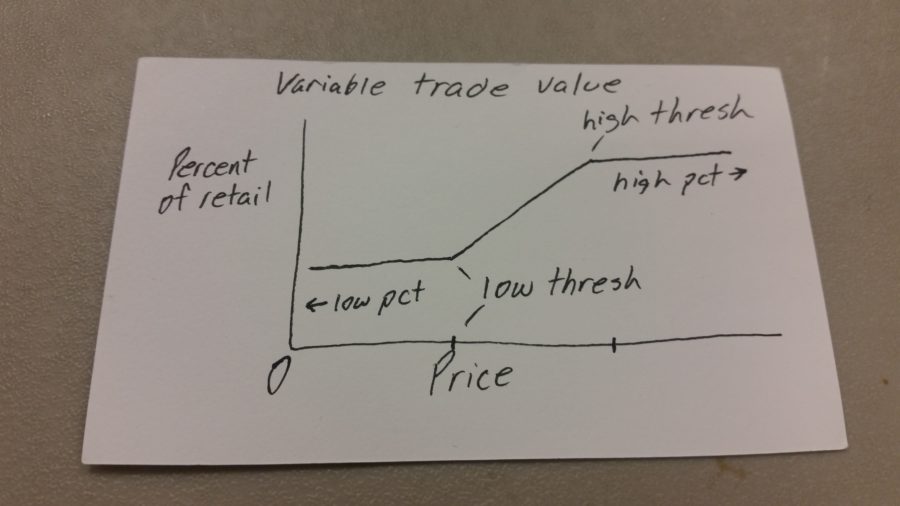
This photo was taken while eating a sandwich at Desert Sky Games in Arizona the week after GAMA 2016. I taught them video games, they taught me comics. I think I got the better end of the trade.
Moving the inflection points of this graph give you a lot of flexibility and power. For categories where the line between good stuff and junk is very fine, you could make the slope of the center line vertical or nearly so. If you want to pay out a flat percentage on a category, you can still do so by setting the low and high percentages to the same number. For categories where the desirability and sales velocity of the items increase steadily as value increases, you could set the LowPercentage/LowThreshold very low and the HighPercentage/HighThreshold very high.
Implementation of this is basically impossible if you’re not running a POS that was designed for game stores. If you look up your prices with a spreadsheet you could probably write this into it, but it would be a pain. In my perfect world, both IMP POS and the Dumpster-Fire Goliath POS solutions would implement this.
Basically, what you want is the formula of a line. This is what it looks like in our system:

Make Money, Improve Life
This is not purposeless fiddling: Very little else in my business changed in the year that I moved to VTV. My total dollars spent on trade-ins dropped by a third, the total volume of my trades increased, and the quality of the inventory I was buying dramatically improved, which meant that sales shot up. My net income jumped by something like 30%. I bought a new vehicle for the first time about six months after I switched this on. These improvements in business process are life-changing.
Examples: Super Nintendo
LowPercentage: 30%
HighPercentage: 65%
LowThreshold: $1.00
HighThreshold: $20.00
CashPenalty: 20%
If you sit down and think about the Super Nintendo games on the used market, you’ll probably come to the conclusion that there’s a handful of garbage low-end titles, a handful of high-value games, and quite a few desirable mid-value games in-between. We’ll look at three examples with their current payouts, and I’ll show you some sales numbers for each going back to the implementation of this software in February 2013 so you can see the larger story for each title and how our pricing has changed.
NHLPA Hockey ’93 – Sell $3.00, Trade $0.70, Buy $0.56
This game is bad. We want some copies of it, but if we paid 50% we’d attract dozens of them. At this payout we’re currently sitting on six copies.
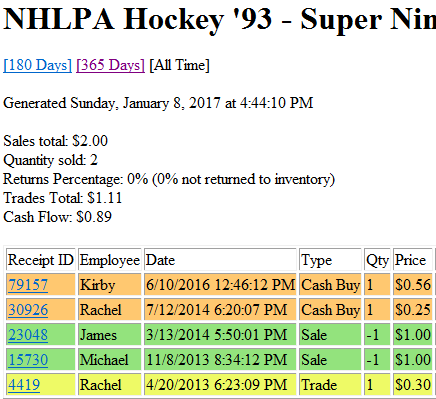
Chrono Trigger – Sell $122.00, Trade $79.30, Buy $63.44
Chrono Trigger is an amazing game, and even if we marked it well above market value, a copy in good condition would be drooled over frequently and eventually sold. We want to give a fair payout for this game, because most people who are getting rid of it know that they could get $120 if they were only willing to deal with the hassle of eBay. If we were paying out a flat 30%, we’d be offering $36.60, which is not a fair trade offer and would upset sellers. We currently have one copy. In the report below you can see how the value of this title has shot up over the last few years.
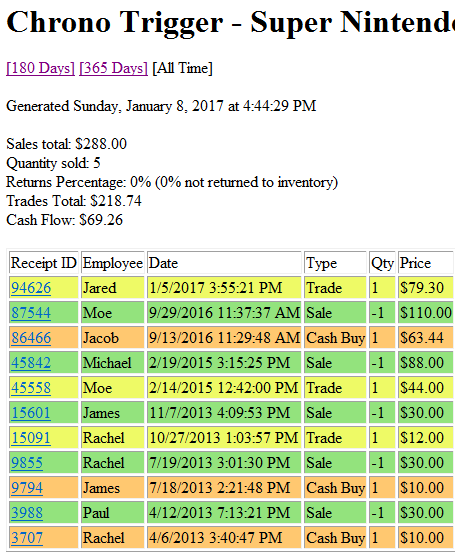
Super Mario World – Sell $17.00, Trade $10.11, Buy $8.09
This is a common, bread-and-butter game that everybody wants, and I could probably get $25 per copy for it without too much trouble. We are currently sold-out in the post-Christmas crush. You can see from the history that it tends to move a little too quickly, meaning that I should think about adjust the pricing manually for both sales and payouts.
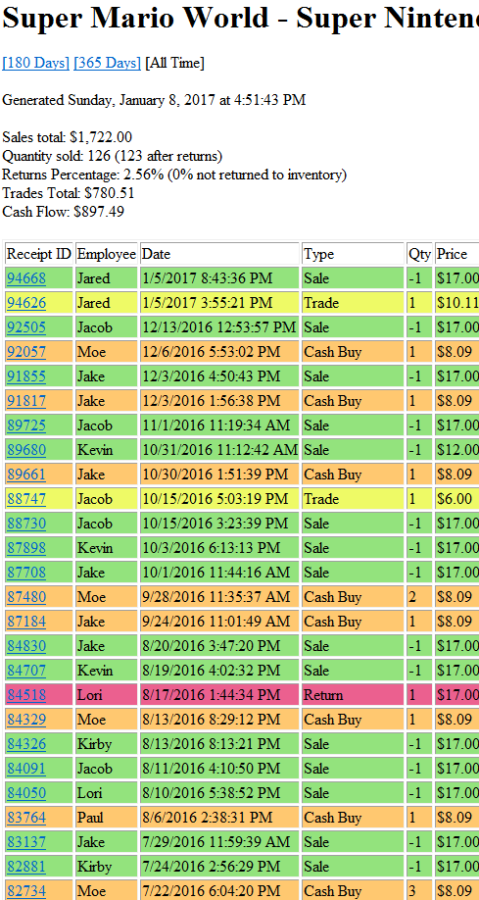
Extra Crunchy Extra Credit
If you’ve got a high enough volume in either games or cards, you can go a little further to protect yourself from anomalies in the trade flow. We haven’t even turned this on in our system yet, but as volume increases it may be useful. For each category we have the following fields in addition to the ones listed above:
- default_optimal: Each item has an optimal quantity number. This is the default for that field. For most video games that’s 12. For Magic singles it might be 8, or 16, or 32, depending on how deep you want to stock. You can always adjust this for individual items if the need for an exception strikes.
- over_optimal_penalty: This is the percentage taken off of a trade if you have over the optimal quantity.
- default_excessive: This is the default for the excessive quantity, which is like optimal quantity but far higher. This is the “hey, there’s something wrong” number. For video games that’s 20 for us.
- over_excessive_penalty: A very high percentage taken off if the quantity in stock is over the excessive number.
Because I Love You: Our category spreadsheet
Here’s the category spreadsheet with all of our values. You can see that many of them are the same. This is one of those 80/20 things where you get the most impact from a relatively small amount of effort. If I wanted to fiddle with it more I could probably squeeze out more efficiencies, but I am trying very hard not to fiddle for a living. It isn’t a super-pretty spreadsheet, with lots of depreciated categories and placeholder values on categories that aren’t price updated regularly, but if you’re data-minded this will help. Video Game pricing comes from PriceCharting and MTG pricing comes from exports of TCGPlayer‘s price data via Gatherer Extractor, since they won’t give out API access to stores for love or money.
I hope this helps someone.

